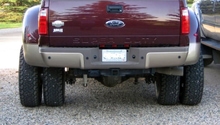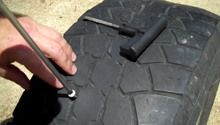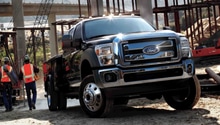Ford F-150: Tires General Information and Maintenance
Learn about your F-150's wheels and tires in depth. We'll break down the components that keep your truck rolling, common questions, and maintenance information.
Tires enhance safe stopping grip, safe lateral traction, safe off-roading, and safe acceleration. One step down from tires are the wheels and their attachment to your F-150’s suspension by lug nuts and the vehicle’s hub. The other components of your wheels and tires all work in concert to keep your truck gripping the road or slinging dust on the trail.
F-150s and Super Duties have a typical setup: a wheel and tire, six lug nuts, and behind a hub to mount into the suspension. You might have performance, all weather, or off-road tires: it’s all similar.
Tires
There’s other info on the tire, like that it is DOT approved, and where and when your tire was manufactured. Be sure to look at these numbers. Tires have a shelf life of about seven years whether they're used or hidden in a warehouse unmounted. Rubber degrades with age regardless of whether it's used or not. A tire that's driven regularly will likely run out of tread long before then, however.

You can find information about original OE tire size, wheel size, and inflation pressure on a sticker on the driver’s door. This sticker says the F150 came with LT275/65R18 tires front and rear, mounted to 18” by 7.5” J rims. That J indicates a light truck tire with an 18-ply rating. Once you buy aftermarket wheels, larger or smaller, you’ll have to deal with a professional supplier. Not all wheels are strong enough for off-roading, light enough for drag racing, and sturdy enough for pulling. Suggested inflation is 35 psi (240 kPa) measured cold, and that’s important as tires change pressure 1-2 psi for every 10° of ambient temperature change.

Rims
As mentioned above, not all wheels are strong enough for off-roading, light enough for drag racing, or sturdy enough for pulling. Trucks that are typically used for off-road driving or heavy duty use will tend to have smaller rims. The reason for this has to do with the size of the tire. A large tire with a large sidewall and smaller rim will be able to tackle poor road conditions more easily because of the increased amount of sidewall the tire has. Larger rims tend to be heavier and require tires with shorter sidewalls in order to fit in the wheel wells without rubbing. That short sidewall makes the truck's ride more stiff and the tire less flexible. For a street truck, this isn't necessarily a bad thing: a larger rim makes for a shorter sidewall and sporty handling. Paying attention to rim size is also important when you consider modifying your truck. Frequently lift kits come with new wheel spindles that may or may not fit inside smaller rims.
Rims deterimine how wide your tires can be, which is important when preparing your truck for different conditions. A narrower rim and tire combo can be better in snowy conditions, for example. Alternatively, a wider rim will allow for a wider tire and more traction. The options are endless. What that means for the F-150 owner is that they must be careful when choosing a set of wheels for their truck. Too wide a rim, or a rim with too much offset will cause rubbing and other suspension issues. Check out our article on wheel fitment in the links below.
(Related Article: Tire Modifications and Size Calculator - Ford-Trucks.com)
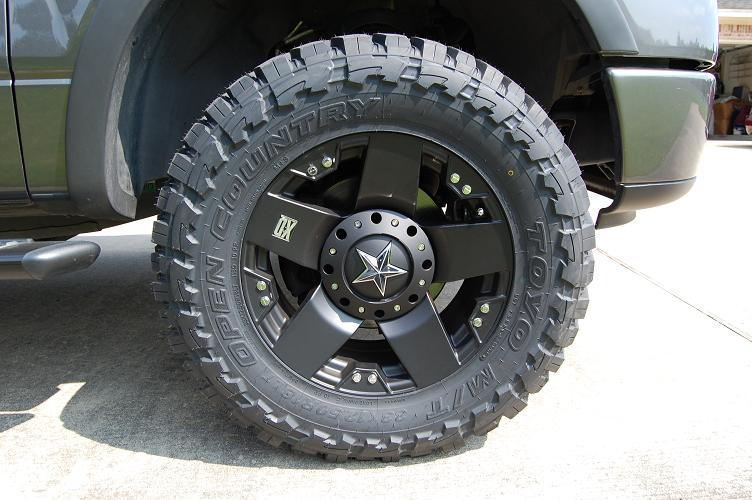
Tire Bolt Patterns
Wheels attach to a hub with lug nuts. It's important to know your trucks' bolt pattern when you're looking for new wheels, too. F-150's have kept their 6x135mm bolt pattern since 2004. This means that there are six bolts evenly spaced in a 135mm circle. F-250's and other Super Duty trucks have a bolt pattern of 8x170mm. These patterns are not standardized across makes, so be careful if you're buying wheels from someone with, say, a Ram 1500. They might be the same class of truck as the F-150, but the Ram's bolt pattern is 5x170.

Lug Nuts
Lug nuts attach the wheel to the threads protruding from the wheel hub. When you dismount a wheel, clean the threads and DO NOT use anti-seize on the threads. Lubricant changes torque whether only under the lug nut or on threads, and it causes thread or fastener failure. If your studs or lug nuts are corroded get new ones.
Lug nuts are also not universal, so be sure you use nuts for your wheel package. Do NOT tighten in a circle: go opposites in a star pattern light, close to rated torque, and properly torqued. Get a torque wrench and use it!

Valve Stem
Standard part in every tire. Not the most glamorous, but definitely important. If you have old tires that you suspect are leaking air, check out this little rubber nub first. The stem likes to crack at point where it meets the rest of the tire. Luckily, they're easy (and cheap) to fix and replace.
(Related Article: How to Replace Valve Stem - Ford-Trucks.com)

TPMS
Beyond the tires, every truck or car built in the US since 2008 must be equipped with a TPMS or tire pressure monitoring system. Some manufacturers infer tire pressure from the ABS system indirectly: deflated tires roll less easily. Direct systems use internal or external pressure sensors. They may report a low tire, or in upscale trucks, report individual pressures on the driver’s display. If you don’t have them, aftermarket suppliers offer TPMS systems.

Figure 6. Valve Stem Style Tire Pressure Monitor 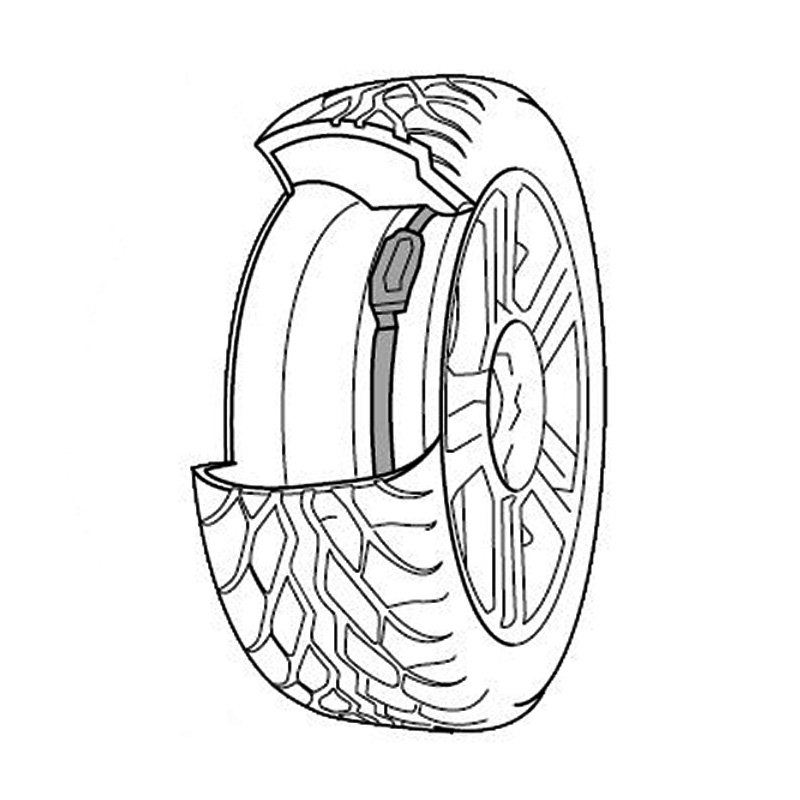
Figure 7. Band Style TPMS Monitor
Scheduled Maintenance
Note that tires, properly inflated, are part of the suspension system and affect overall spring rates. Underinflated tires wear faster, decrease fuel economy up to 15%, and are unsafe in every way. Checking your tires weekly, or at least biweekly, is crucial!
(Related: How to Check Tire Tread - Ford-Trucks.com )
Common Questions
What's the difference between tire types?
There are two basic categories of tire that F-150 owners need to understand: P-rated tires and LT-rated tires. P stands for passenger. These tires are the same kind of tires that you'd put on a car. F-150s come with these from the factory because they're a good compromise between on-road comfort and towing capacity. LT stands for light truck. Typically, this is the preferred tire type in the enthusiast and work communities. These tires have a considerably higher load capacity and are generally more rugged that their P class counterparts.
How do I tell how long a tire can last?
All tires come with a treadwear grade rating that's supposed to give the buyer an idea of how long a tire should last in comparison to another. The higher the number is, the longer the tread on that tire will last. This applies to both P-class tires and the LT-class. What those tire wear ratings won't tell you is how many miles the tire will last. Most tire companies will warranty a tire for a certain number of miles. This is often the best way to get an idea of how long a tire's tread will actually last.
Is filling my tires with nitrogen worth it?
The general consensus is that filling your tires with nitrogen is technically better, but effectively the same as normal air. Nitrogen gas has properties that are useful in a tire. It doesn't expand as much under heat, meaning your tire's PSI won't fluctuate as much when in use. That means better fuel mileage and less leakage. However, the difference that this will make in practice is minor. So should you? Sure, but don't bother if it's going to cost you.
Related Discussions and Sites
- General Tire Info FAQ - F150forum.com
- Nitrogen Filled tires: Worth It? - F150online.com
- P Tires vs LT Tires - F150online.com
- Switching from P to LT - Ford-Trucks.com
- Gas Mileage vs Tires - F150forum.com
- F-150 Owners Manual - Ford
- Ford Bolt Patterns - FordBoltPattern.com

